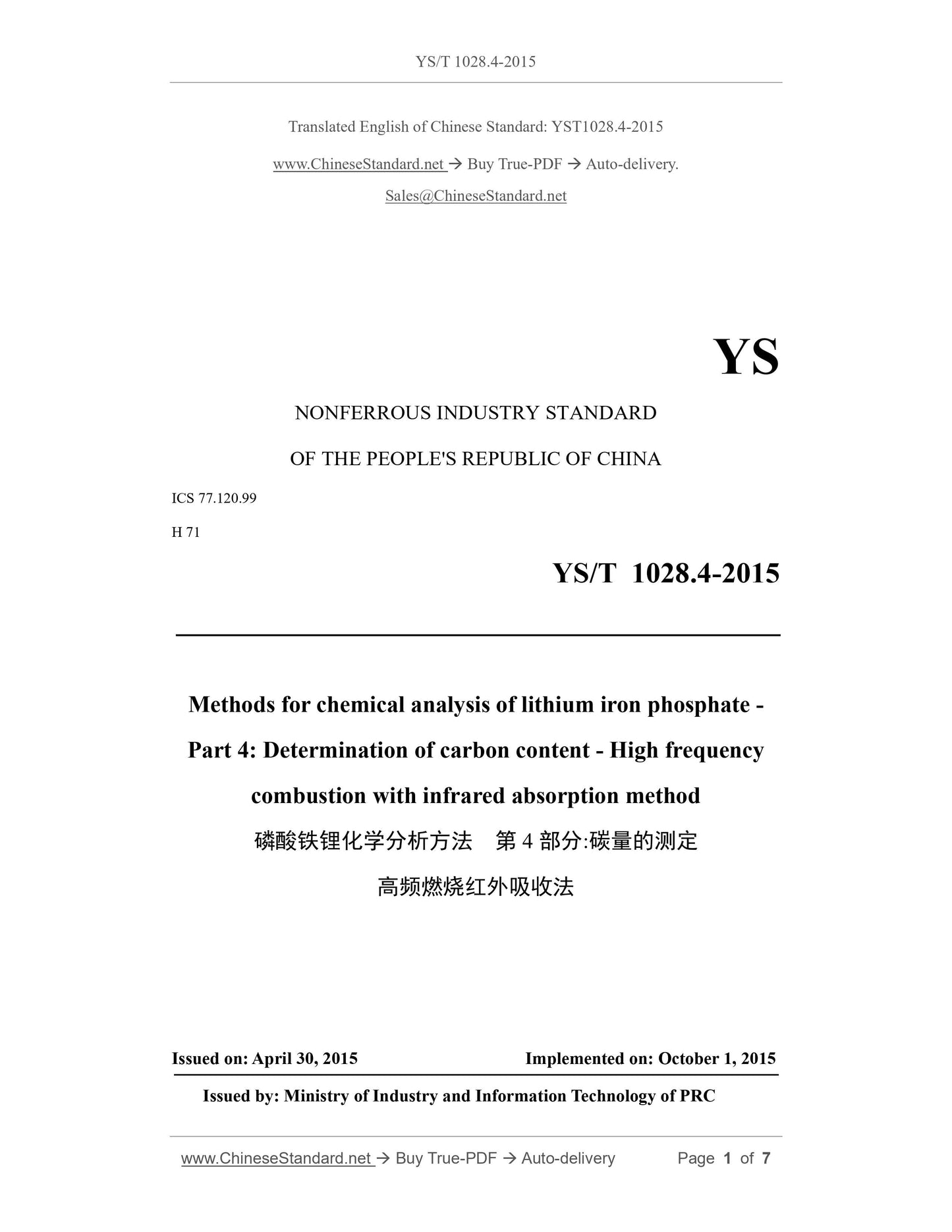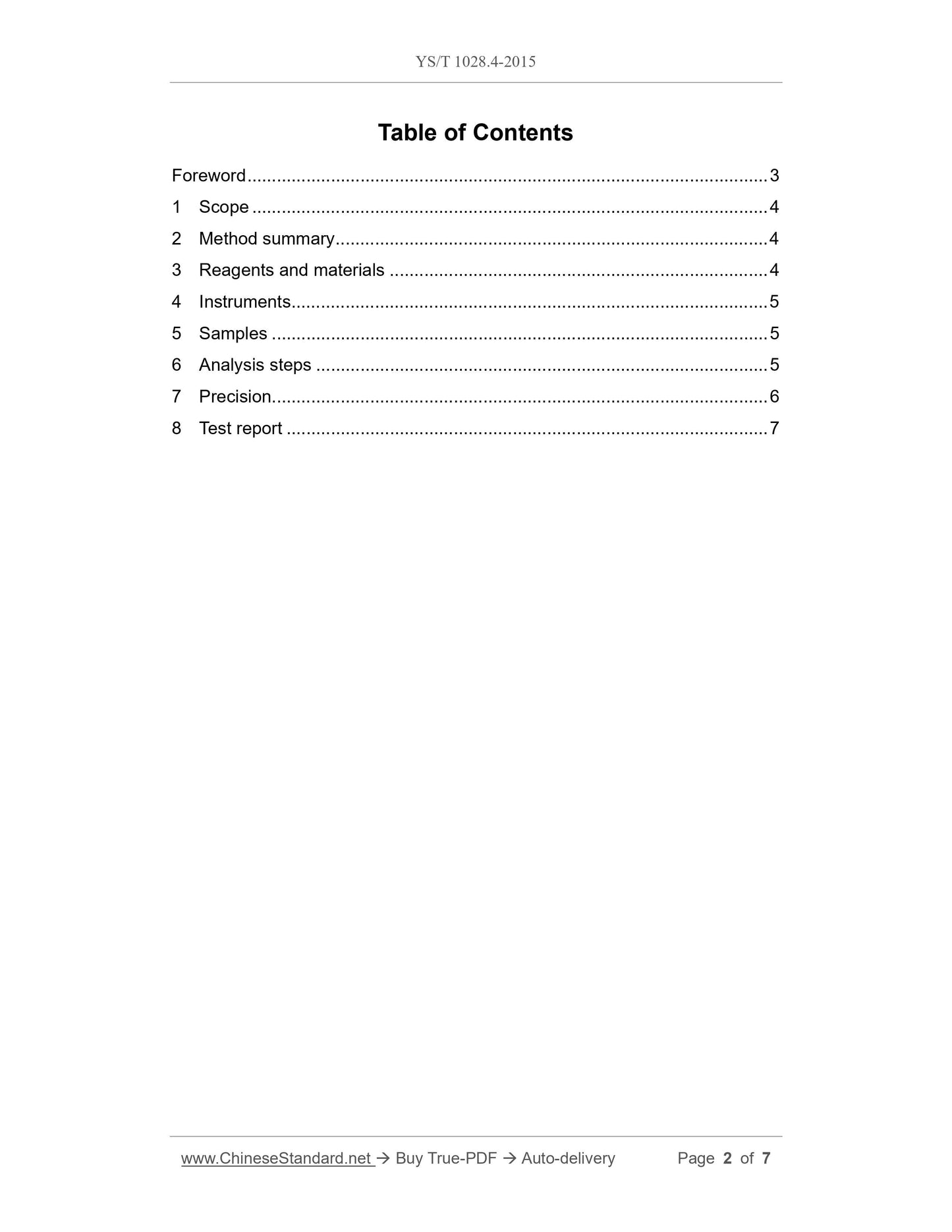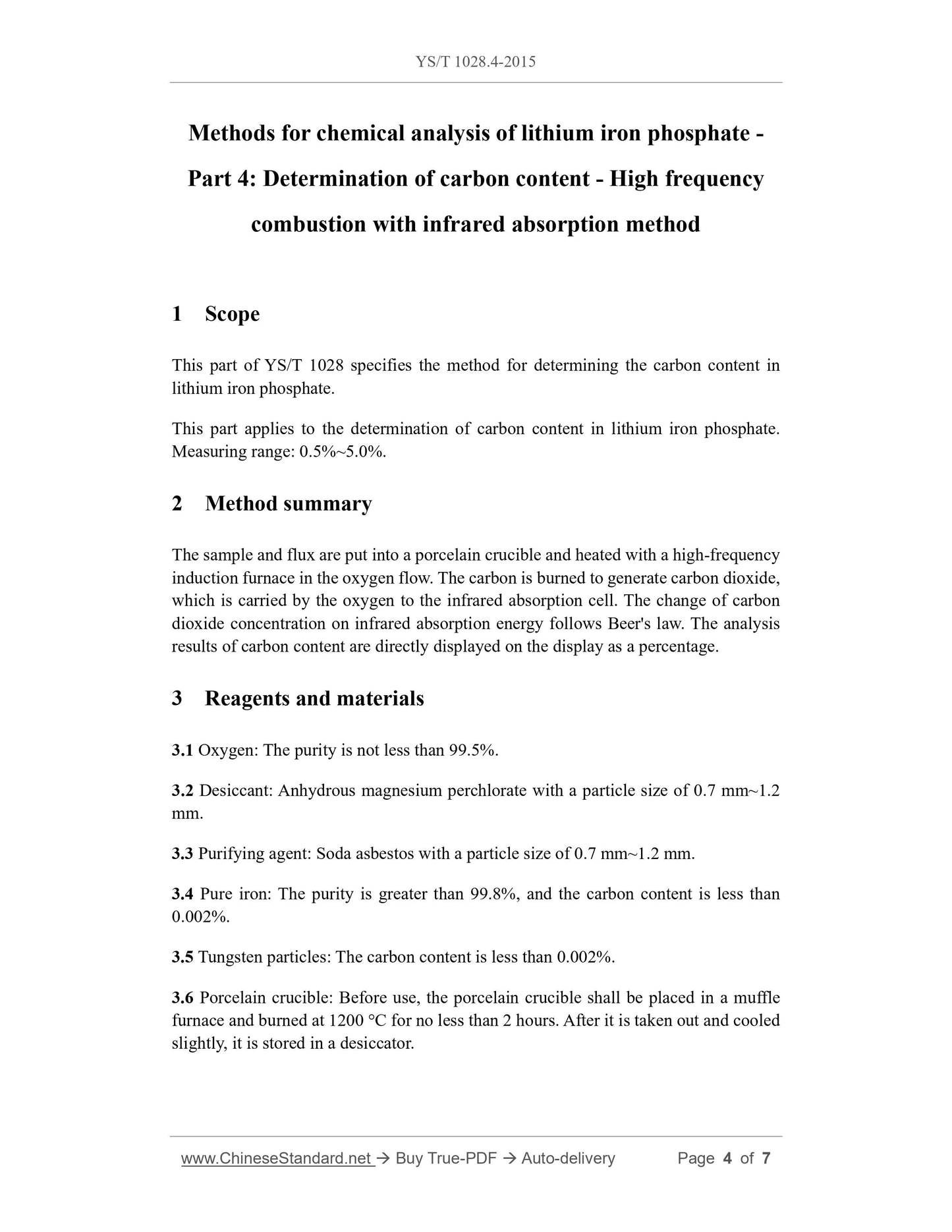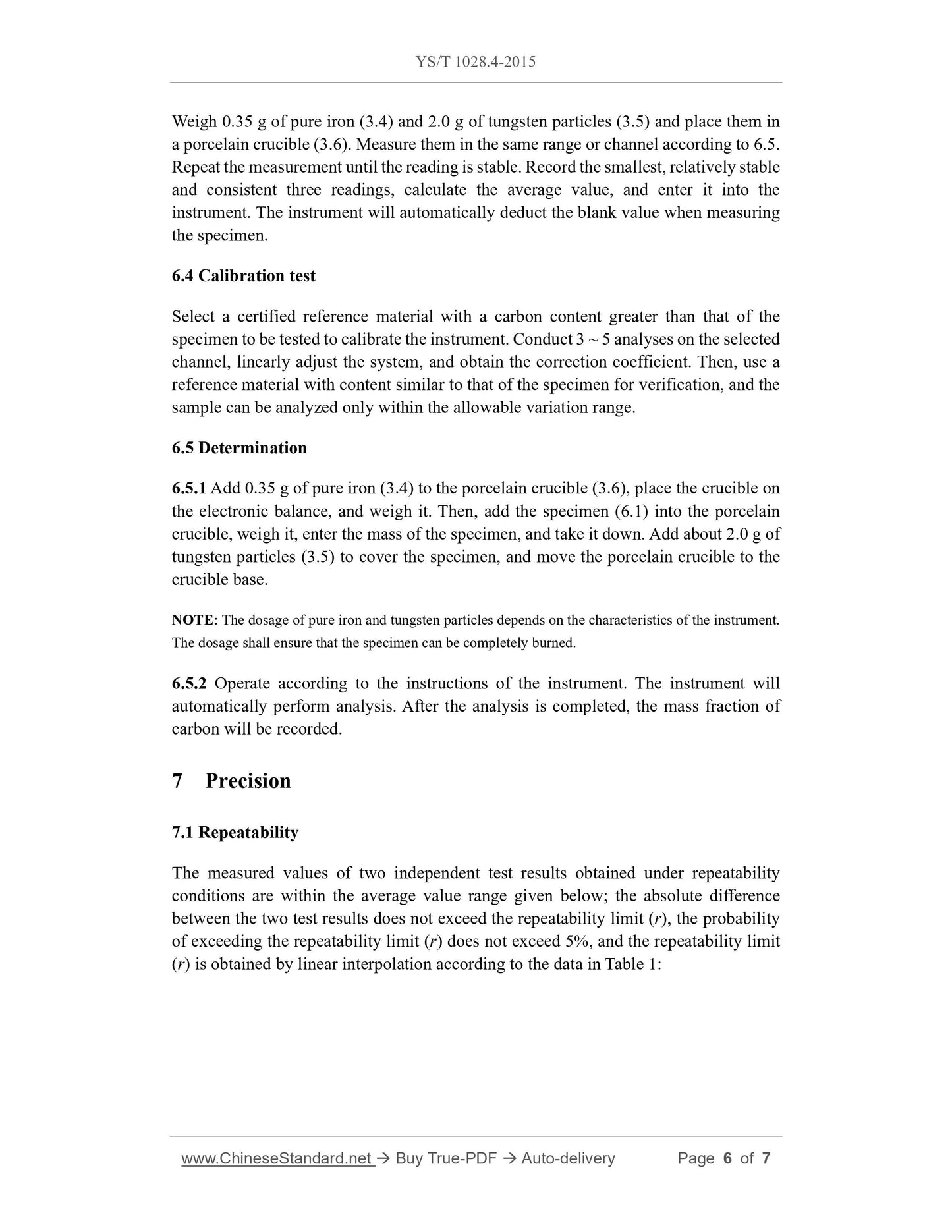1
/
/
4
PayPal, credit cards. Download editable-PDF and invoice in 1 second!
YS/T 1028.4-2015 English PDF (YST1028.4-2015)
YS/T 1028.4-2015 English PDF (YST1028.4-2015)
Normaalihinta
$115.00 USD
Normaalihinta
Alennushinta
$115.00 USD
Yksikköhinta
/
kohti
Toimituskulut lasketaan kassalla.
Noudon saatavuutta ei voitu ladata
Delivery: 3 seconds. Download true-PDF + Invoice.
Get QUOTATION in 1-minute: Click YS/T 1028.4-2015
Historical versions: YS/T 1028.4-2015
Preview True-PDF (Reload/Scroll if blank)
YS/T 1028.4-2015: Methods for chemical analysis of lithium iron phosphate. Part 4: Determination of carbon content. High frequency combustion with infrared absorption method
YS/T 1028.4-2015
YS
NONFERROUS INDUSTRY STANDARD
OF THE PEOPLE'S REPUBLIC OF CHINA
ICS 77.120.99
H 71
Methods for chemical analysis of lithium iron phosphate -
Part 4: Determination of carbon content - High frequency
combustion with infrared absorption method
ISSUED ON: APRIL 30, 2015
IMPLEMENTED ON: OCTOBER 1, 2015
Issued by: Ministry of Industry and Information Technology of PRC
Table of Contents
Foreword ... 3
1 Scope ... 4
2 Method summary ... 4
3 Reagents and materials ... 4
4 Instruments ... 5
5 Samples ... 5
6 Analysis steps ... 5
7 Precision... 6
8 Test report ... 7
Methods for chemical analysis of lithium iron phosphate -
Part 4: Determination of carbon content - High frequency
combustion with infrared absorption method
1 Scope
This part of YS/T 1028 specifies the method for determining the carbon content in
lithium iron phosphate.
This part applies to the determination of carbon content in lithium iron phosphate.
Measuring range: 0.5%~5.0%.
2 Method summary
The sample and flux are put into a porcelain crucible and heated with a high-frequency
induction furnace in the oxygen flow. The carbon is burned to generate carbon dioxide,
which is carried by the oxygen to the infrared absorption cell. The change of carbon
dioxide concentration on infrared absorption energy follows Beer's law. The analysis
results of carbon content are directly displayed on the display as a percentage.
3 Reagents and materials
3.1 Oxygen: The purity is not less than 99.5%.
3.2 Desiccant: Anhydrous magnesium perchlorate with a particle size of 0.7 mm~1.2
mm.
3.3 Purifying agent: Soda asbestos with a particle size of 0.7 mm~1.2 mm.
3.4 Pure iron: The purity is greater than 99.8%, and the carbon content is less than
0.002%.
3.5 Tungsten particles: The carbon content is less than 0.002%.
3.6 Porcelain crucible: Before use, the porcelain crucible shall be placed in a muffle
furnace and burned at 1200 °C for no less than 2 hours. After it is taken out and cooled
slightly, it is stored in a desiccator.
Weigh 0.35 g of pure iron (3.4) and 2.0 g of tungsten particles (3.5) and place them in
a porcelain crucible (3.6). Measure them in the same range or channel according to 6.5.
Repeat the measurement until the reading is stable. Record the smallest, relatively stable
and consistent three readings, calculate the average value, and enter it into the
instrument. The instrument will automatically deduct the blank value when measuring
the specimen.
6.4 Calibration test
Select a certified reference material with a carbon content greater than that of the
specimen to be tested to calibrate the instrument. Conduct 3 ~ 5 analyses on the selected
channel, linearly adjust the system, and obtain the correction coefficient. Then, use a
reference material with content similar to that of the specimen for verification, and the
sample can be analyzed only within the allowable variation range.
6.5 Determination
6.5.1 Add 0.35 g of pure iron (3.4) to the porcelain crucible (3.6), place the crucible on
the electronic balance, and weigh it. Then, add the specimen (6.1) into the porcelain
crucible, weigh it, enter the mass of the specimen, and take it down. Add about 2.0 g of
tungsten particles (3.5) to cover the specimen, and move the porcelain crucible to the
crucible base.
NOTE: The dosage of pure iron and tungsten particles depends on the characteristics of the instrument.
The dosage shall ensure that the specimen can be completely burned.
6.5.2 Operate according to the instructions of the instrument. The instrument will
automatically perform analysis. After the analysis is completed, the mass fraction of
carbon will be recorded.
7 Precision
7.1 Repeatability
The measured values of two independent test results obtained under repeatability
conditions are within the average value range given below; the absolute difference
between the two test results does not exceed the repeatability limit (r), the probability
of exceeding the repeatability limit (r) does not exceed 5%, and the repeatability limit
(r) is obtained by linear interpolation according to the data in Table 1:
Get QUOTATION in 1-minute: Click YS/T 1028.4-2015
Historical versions: YS/T 1028.4-2015
Preview True-PDF (Reload/Scroll if blank)
YS/T 1028.4-2015: Methods for chemical analysis of lithium iron phosphate. Part 4: Determination of carbon content. High frequency combustion with infrared absorption method
YS/T 1028.4-2015
YS
NONFERROUS INDUSTRY STANDARD
OF THE PEOPLE'S REPUBLIC OF CHINA
ICS 77.120.99
H 71
Methods for chemical analysis of lithium iron phosphate -
Part 4: Determination of carbon content - High frequency
combustion with infrared absorption method
ISSUED ON: APRIL 30, 2015
IMPLEMENTED ON: OCTOBER 1, 2015
Issued by: Ministry of Industry and Information Technology of PRC
Table of Contents
Foreword ... 3
1 Scope ... 4
2 Method summary ... 4
3 Reagents and materials ... 4
4 Instruments ... 5
5 Samples ... 5
6 Analysis steps ... 5
7 Precision... 6
8 Test report ... 7
Methods for chemical analysis of lithium iron phosphate -
Part 4: Determination of carbon content - High frequency
combustion with infrared absorption method
1 Scope
This part of YS/T 1028 specifies the method for determining the carbon content in
lithium iron phosphate.
This part applies to the determination of carbon content in lithium iron phosphate.
Measuring range: 0.5%~5.0%.
2 Method summary
The sample and flux are put into a porcelain crucible and heated with a high-frequency
induction furnace in the oxygen flow. The carbon is burned to generate carbon dioxide,
which is carried by the oxygen to the infrared absorption cell. The change of carbon
dioxide concentration on infrared absorption energy follows Beer's law. The analysis
results of carbon content are directly displayed on the display as a percentage.
3 Reagents and materials
3.1 Oxygen: The purity is not less than 99.5%.
3.2 Desiccant: Anhydrous magnesium perchlorate with a particle size of 0.7 mm~1.2
mm.
3.3 Purifying agent: Soda asbestos with a particle size of 0.7 mm~1.2 mm.
3.4 Pure iron: The purity is greater than 99.8%, and the carbon content is less than
0.002%.
3.5 Tungsten particles: The carbon content is less than 0.002%.
3.6 Porcelain crucible: Before use, the porcelain crucible shall be placed in a muffle
furnace and burned at 1200 °C for no less than 2 hours. After it is taken out and cooled
slightly, it is stored in a desiccator.
Weigh 0.35 g of pure iron (3.4) and 2.0 g of tungsten particles (3.5) and place them in
a porcelain crucible (3.6). Measure them in the same range or channel according to 6.5.
Repeat the measurement until the reading is stable. Record the smallest, relatively stable
and consistent three readings, calculate the average value, and enter it into the
instrument. The instrument will automatically deduct the blank value when measuring
the specimen.
6.4 Calibration test
Select a certified reference material with a carbon content greater than that of the
specimen to be tested to calibrate the instrument. Conduct 3 ~ 5 analyses on the selected
channel, linearly adjust the system, and obtain the correction coefficient. Then, use a
reference material with content similar to that of the specimen for verification, and the
sample can be analyzed only within the allowable variation range.
6.5 Determination
6.5.1 Add 0.35 g of pure iron (3.4) to the porcelain crucible (3.6), place the crucible on
the electronic balance, and weigh it. Then, add the specimen (6.1) into the porcelain
crucible, weigh it, enter the mass of the specimen, and take it down. Add about 2.0 g of
tungsten particles (3.5) to cover the specimen, and move the porcelain crucible to the
crucible base.
NOTE: The dosage of pure iron and tungsten particles depends on the characteristics of the instrument.
The dosage shall ensure that the specimen can be completely burned.
6.5.2 Operate according to the instructions of the instrument. The instrument will
automatically perform analysis. After the analysis is completed, the mass fraction of
carbon will be recorded.
7 Precision
7.1 Repeatability
The measured values of two independent test results obtained under repeatability
conditions are within the average value range given below; the absolute difference
between the two test results does not exceed the repeatability limit (r), the probability
of exceeding the repeatability limit (r) does not exceed 5%, and the repeatability limit
(r) is obtained by linear interpolation according to the data in Table 1:
Share








